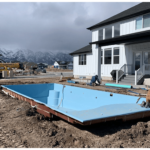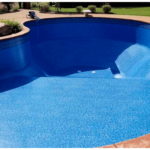Información actualizada April 4, 2024
Fiberglass Pools Resurfacing – If you own a fiberglass pool, you know that it’s a great investment for your home. Fiberglass pools are durable, low-maintenance, and long-lasting. However, over the years, your fiberglass pool can begin to show signs and symptoms of wear and tear and tear. Cracks, chips, and discoloration are common troubles that can have an effect on the look and feature of your pool. The good news is that resurfacing your fiberglass pool can help restore it to its original beauty and function. In this guide, we’ll discuss the basics of fiberglass pool resurfacing and what you need to know before starting this project.
Table of Contents
Why Resurface a Fiberglass Pool?
There are several reasons why you might consider resurfacing your fiberglass pool. First, in case your pool is greater than 10 years vintage, it may start to expose signs of damage and tear. Cracks, chips, and discoloration can occur over time, making your pool look unsightly and potentially affecting its function. Resurfacing your pool can help restore it to its original beauty and function.
Second, if you’re planning to sell your home, resurfacing your pool can increase its value. A nicely-maintained pool can be a promoting point for capacity customers and permit you to get a higher price for your home.
Finally, resurfacing your fiberglass pool can help extend its lifespan. Fiberglass pools are durable, but they can still be affected by the elements and other factors. Resurfacing your pool can help protect it from damage and keep it looking great for years to come.
How to Resurface a Fiberglass Pool
Resurfacing a fiberglass pool is a complex process that requires professional expertise. Here are the basic steps involved in the process:
Step 1: Drain the Pool
The first step in resurfacing your fiberglass pool is to drain the water. This is typically done using a submersible pump.
Step 2: Remove the Old Surface
Next, the old surface of the pool needs to be removed. This will be accomplished the usage of a grinder or sander. The goal is to remove any loose or damaged areas so that the new surface can adhere properly.
Step 3: Repair Any Damage
If there are any cracks, chips, or different damage to the pool, those want to be repaired before the new surface may be implemented. This may involve filling in the damaged area with epoxy or other materials.
Step 4: Apply the New Surface
Once the pool has been drained, cleaned, and repaired, the new surface can be applied. This is typically done using a spray-on or roll-on application. The new surface will need to cure for several days before the pool can be refilled.
Step 5: Refill the Pool
Once the new surface has cured, the pool can be refilled with water. It’s important to follow the manufacturer’s instructions for filling the pool to ensure that the new surface sets properly.
DIY vs. Professional Resurfacing
While it’s possible to resurface a fiberglass pool yourself, it’s not recommended. Resurfacing a pool is a complex process that requires professional expertise and specialized equipment. If you’re not experienced in this type of work, you could end up causing more damage to your pool or creating an unsafe environment.
Professional pool resurfacing companies have the experience, knowledge, and equipment to resurface your pool safely and effectively. They can also provide warranties and ensures on their paintings, giving you peace of thoughts and protection for your funding.
Cost of Fiberglass Pool Resurfacing
The price of fiberglass pool resurfacing can range depending on numerous factors, together with the scale of the pool, the volume of harm, and the form of surface you choose. On common, you could expect to pay among $5,000 and $15,000 for pool resurfacing. but, take into account that that is a long-time period investment that may add fee to your own home and expand the lifespan of your pool.
Comparative table of different options for restoring a fiberglass pool with approximate costs, durability, and materials:
| Restoration Option | Approximate Cost | Durability | Materials |
|---|---|---|---|
| Gelcoat Refinishing | $2,500-$5,000 | 5-10 years | Gelcoat |
| Fiberglass Resurfacing | $4,000-$8,000 | 10-15 years | Fiberglass mat and resin |
| Epoxy Coating | $4,500-$7,500 | 10-15 years | Epoxy resin |
| Vinyl Liner Installation | $6,000-$10,000 | 10-15 years | Vinyl liner |
| Tile and Coping Replacement | $10,000-$15,000 | 20+ years | Tile and coping materials |
Maintenance After Resurfacing
Once your pool has been resurfaced, it’s important to take proper care of it to ensure its longevity. Regular maintenance, such as cleaning and balancing the water chemistry, can help prevent future damage and extend the life of your pool’s surface.
It’s also important to avoid harsh chemicals or abrasive materials that can damage the new surface. Use only recommended cleaning products and tools, and avoid heavy use of pool equipment or toys that can scratch or damage the surface.
Expertise Fiberglass pools Resurfacing
What’s Fiberglass Pool Resurfacing? Fiberglass Pools Resurfacing
Fiberglass pool resurfacing is the process of applying a sparkling layer of resurfacing material to the present fiberglass pool shell. This method facilitates restore the pool’s appearance, smoothness, and structural integrity. Over the years, publicity to chemicals and the elements can motive the original gelcoat or surface to go to pot, leading to cracks, fading, and roughness. Resurfacing offers an powerful answer to increase the lifespan of your pool.
Signs and symptoms Your Fiberglass Pool wishes Resurfacing
- Cracks and Fractures: visible cracks or fractures in the pool’s floor suggest the want for resurfacing.
- Stains and Discoloration: cussed stains and discoloration that withstand cleansing can be resolved thru resurfacing.
- Tough Texture: If the pool’s floor feels hard to the touch, it’s time for resurfacing.
- Fading shade: dwindled or stupid shade is a clear sign that the pool’s floor is deteriorating.
Practise for Resurfacing
Gathering the important equipment and substances
Earlier than you start the resurfacing procedure, gather all the required gear and substances. You may need sandpaper, resurfacing material (gelcoat, epoxy, or polyurea), protective tools, a sander, a roller, and brushes.
Draining and cleansing the Pool
Start by means of draining the pool completely and carefully cleansing the surface. Eliminate any particles, leaves, or algae buildup. A easy floor ensures right adhesion of the new resurfacing material.
Assessing Structural problems
Look at the pool shell for any structural problems, such as cracks that amplify past the surface. Addressing these issues before resurfacing is essential to ensure the sturdiness of the new floor.
Deciding on the right Resurfacing cloth
Gelcoat Resurfacing – Fiberglass Pools Resurfacing
Gelcoat is a famous preference for fiberglass pool resurfacing. It is a easy and durable fabric that can repair the pool’s authentic finish. Gelcoat comes in diverse colors and affords a sleek appearance.
Epoxy Resurfacing
Epoxy gives extraordinary durability and chemical resistance. It is a versatile fabric which could resist heavy use and provides a long-lasting finish.
Polyurea Coating
Polyurea is understood for its fast curing time and flexibility. It creates a strong and waterproof surface that may adapt to temperature modifications with out cracking.
Step-by way of-Step Resurfacing process
Sanding and Stripping the antique floor – Fiberglass Pools Resurfacing
Start by sanding the antique surface to create a hard texture for higher adhesion. Strip away any remnants of the antique fabric and make sure a easy, clean base.
Applying the Resurfacing fabric
Follow the manufacturer’s instructions to combine and follow the selected resurfacing fabric. Use a curler and brushes to evenly spread the material across the pool’s floor.
Smoothing and Buffing for a seamless end
Once the material is implemented, clean out any choppy areas and air bubbles. Buff the floor to reap a continuing and polished finish.
Curing and finishing Touches
Permitting sufficient Curing Time – Fiberglass Pools Resurfacing
Give the resurfaced pool adequate time to therapy in step with the manufacturer’s recommendations. Keep away from using the pool until the curing system is complete.
Adding finishing Touches to enhance durability
Practice a very last layer of shielding sealant to beautify the durability and toughness of the resurfaced surface. This deposit adds an extra barrier towards chemicals and environmental elements.
Retaining Your Resurfaced Fiberglass Pool
Regular cleansing and preservation
To extend the life of your resurfaced pool, set up a recurring cleansing time table. Use pool-secure cleaning merchandise and brushes to keep the floor free from dust, debris, and algae.
Suggestions to extend the Lifespan of the Resurfaced floor
Balanced Water Chemistry: preserve proper water chemistry to save you harm to the resurfaced surface.
Keep away from Sharp gadgets: Discourage activities that can lead to scratches or harm to the surface.
Normal Inspections: Periodically check out the floor for any symptoms of wear and tear or harm.
Conclusion
Fiberglass pool resurfacing is a great way to restore the beauty and function of your pool. By following the proper steps and working with a professional resurfacing company, you can enjoy a pool that looks and performs like new for years to come. Remember to take proper care of your newly resurfaced pool to ensure its longevity and protect your investment.
FAQs
- How long does fiberglass pool resurfacing take?
Answer: The time it takes to resurface a fiberglass pool can range relying on the scale of the pool and the quantity of the harm. On common, it can take anywhere from some days to every week or extra to complete the resurfacing system. - How often should I resurface my fiberglass pool?
Answer: The frequency of resurfacing your fiberglass pool can vary depending on factors such as usage, maintenance, and climate. On average, you can expect to resurface your pool every 10-15 years. - Can I resurface my fiberglass pool myself?
Answer: While it’s possible to resurface a fiberglass pool yourself, it’s not recommended. Resurfacing a pool is a complex process that requires professional expertise and specialized equipment. - How much does fiberglass pool resurfacing cost?
Answer: The cost of fiberglass pool resurfacing can vary relying on several elements, along with the scale of the pool, the volume of harm, and the sort of surface you select. On average, you may expect to pay between $5,000 and $15,000 for pool resurfacing. - Can I use my pool immediately after resurfacing?
Answer: No, you should wait until the new surface has cured before refilling the pool and using it. This can take several days, so be sure to follow the manufacturer’s instructions for filling and curing the pool before use.


